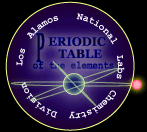

| Atomic Number: | 18 | Atomic Radius: | 174 pm | ||
| Atomic Symbol: | Ar | Melting Point: | -189.35 �C | ||
| Atomic Weight: | 39.948 | Boiling Point: | -185.85 �C | ||
| Electron Configuration: | [Ne]3s23p6 | Oxidation States: | -- |
(Gr. argos, inactive) Its presence in air was suspected by Cavendish in 1785, discovered by Lord Raleigh and Sir William Ramsay in 1894.
The gas is prepared by fractionation of liquid air because the atmosphere contains 0.94% argon. The atmosphere of Mars contains 1.6% of 40Ar and 5 p.p.m. of 36Ar.
Argon is two and one half times as soluble in water as nitrogen, having about the same solubility as oxygen. Argon is colorless and odorless, both as a gas and liquid. Argon is considered to be a very inert gas and is not known to form true chemical compounds, as do krypton, xenon, and radon.
Naturally occurring argon is a mixture of three isotopes. Twelve other radioactive isotopes are known to exist.
It is used in electric light bulbs and in fluorescent tubes at a pressure of about 400 Pa. and in filling photo tubes, glow tubes, etc. Argon is also used as an inert gas shield for arc welding and cutting, as blanket for the production of titanium and other reactive elements, and as a protective atmosphere for growing silicon and germanium crystals.
Title Picture: Argon gas is used to fill light bulbs.

Sources: CRC Handbook of Chemistry and Physics and the American Chemical Society.
Last Updated: 12/15/2003, � Chemistry Operations
Operated by the University
of California for the US Department
of Energy
|
Help
| Copyright � UC 2003 | Disclaimer